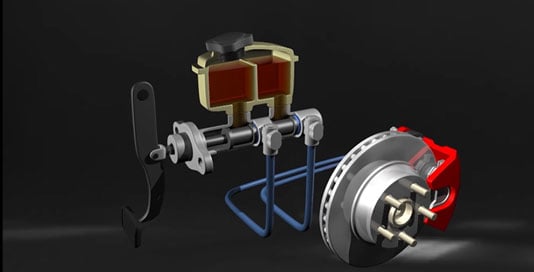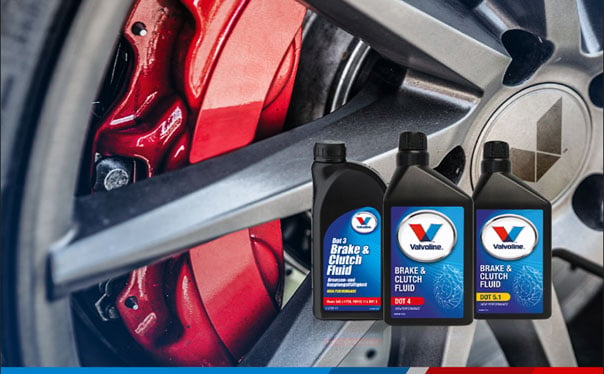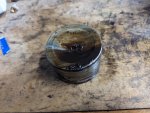-
Steel Soldiers now has a few new forums, read more about it at: New Munitions Forums!
PSA for Silicone Brake Fluid
- Thread starter 87cr250r
- Start date

More options
Who Replied?That's chunky!! First thing I do when I get one of these is flush it out and put dot 3 in them...then flush them some more every year.If you're running DOT 5 brake fluid it's probably time you opened and cleaned your calipers.
View attachment 892949
Yeah, I'm really on the fence with the DOT 3 conversion. I'm annoyed with myself because I've done the brake system one item at a time over 10 years. Master cylinder, rear cylinders, and now front. I've never had a good opportunity to just swap everything. Oh well, it's 37 years old and still stopped fine.
This is my first time rebuilding an automotive caliper, done many motorcycle calipers. Cheap parts but what a PITA getting the dust seal set right. Double check your work and push the pistons out with air. Use a 1.75" block as a stop for the piston.
This is my first time rebuilding an automotive caliper, done many motorcycle calipers. Cheap parts but what a PITA getting the dust seal set right. Double check your work and push the pistons out with air. Use a 1.75" block as a stop for the piston.
I figured they can use either so I went with the dot 3 since it's very cheap and easy to get. I didn't rebuild anything first just used my pressure tank to push it out! Yes I would rebuild my calipers too, that's cheap and easy as well.Yeah, I'm really on the fence with the DOT 3 conversion. I'm annoyed with myself because I've done the brake system one item at a time over 10 years. Master cylinder, rear cylinders, and now front. I've never had a good opportunity to just swap everything. Oh well, it's 37 years old and still stopped fine.
This is my first time rebuilding an automotive caliper, done many motorcycle calipers. Cheap parts but what a PITA getting the dust seal set right. Double check your work and push the pistons out with air. Use a 1.75" block as a stop for the piston.
The trick to getting the dust seal set correctly is to install the inner o-ring first(lubricated with your choice of brake fluid), then install the dust seal all around in its slot in the caliper. Then lightly coat the piston with brake fluid and place it on top of the dust seal. Using a low pressure burst of air into the caliper at the brake line connection you inflate the dust seal onto the piston. Then using the tool of your choice, press the piston into the caliper. I always used a 3/4” combo wrench laying flat on the piston and press it in.
- 445
- 836
- 93
- Location
- Orygun
So I don't have to run the expensive fancy blue fluid in my old M35A2 ??
There are no differences in components between a DOT 3/4 and DOT 5 brake system. All of the materials are the same so you can run either fluid system. It's all EPDM rubber.
But! I feel (not know) that the combination of the two fluids is harmful. I don't have proof to back this up but I've seen the master cylinder gasket swell in systems with mixed fluids. I don't know what the mixed fluids were but I assume it was DOT 3 and DOT 5. But, maybe someone put power steering fluid on the master. That would certainly cause the damage.I saw. I don't know for sure.
But! I feel (not know) that the combination of the two fluids is harmful. I don't have proof to back this up but I've seen the master cylinder gasket swell in systems with mixed fluids. I don't know what the mixed fluids were but I assume it was DOT 3 and DOT 5. But, maybe someone put power steering fluid on the master. That would certainly cause the damage.I saw. I don't know for sure.
The trick to getting the dust seal set correctly is to install the inner o-ring first(lubricated with your choice of brake fluid), then install the dust seal all around in its slot in the caliper. Then lightly coat the piston with brake fluid and place it on top of the dust seal. Using a low pressure burst of air into the caliper at the brake line connection you inflate the dust seal onto the piston. Then using the tool of your choice, press the piston into the caliper. I always used a 3/4” combo wrench laying flat on the piston and press it in.
I put the dust seal on the piston and stretched it until the caliper side was below the piston. This let me place the seal in the groove and then push the piston in.
This is the dust seal, the piston seal was in its groove from the beginning.
- 7,716
- 19,766
- 113
- Location
- Charlotte NC
.So I don't have to run the expensive fancy blue fluid in my old M35A2 ??
This is almost the Ford vs Chevy debate. Only difference being that DOT 3 is cheaper and works just fine. And, if you have a burning desire to have silicone brake fluid (the DOT 5 stuff) it will work just fine too. Mixing DOT 5 and DOT 3 is bad MoJo. You can use either but not both. Changing from one to the other can be done but you have to drain the fluid (force it out with air).
-----
I went to the Valvoline site to get one manufacturers "take" on the question on mixing types and a little more detail. Everything below this line came from them.
-----
VEHICLE MAINTENANCE: BRAKE FLUID DOT 3, DOT 4, DOT 5.1, AND DOT 5
A vehicle’s braking system is a critical system for adjusting the speed of movement of the vehicle, or slowing down or stopping it. Brake fluid is a specialty fluid that ensures effective stopping power by transferring brake pedal force to the brake pads. It also has lubricating and anti-corrosion properties that improve the brake system’s functionality and performance and extend its operating life. All of these functions make brake fluid selection a particularly important task of vehicle maintenance.

Different types of brake fluids match the requirements of specific braking systems. The most common ones used today are DOT 3, DOT 4, DOT 5, and DOT 5.1 brake fluids.
Are all brake fluids the same? If not, what is the difference between these specialty fluids?
Here’s what you need to know.
WHAT ARE BRAKE FLUID MAJOR FEATURES?
The braking system is a mechanism with extreme operating temperatures. That is why the brake fluid needs to possess certain features to be able to meet those conditions. Moreover, its major features include:
- Non-compressibility - For effective force transfer
- Low viscosity - For compatibility with ABS
- Lubricity - For lubricating the sealings
- Corrosion resistance - For protecting braking system components
- High boiling point - For resisting high temperatures and not vaporizing, which would affect the transfer of the braking force.
DOT is an abbreviation for the US Department of Transportation. What’s more, it indicates the brake fluid grades specified by the Federal Motor Vehicle Safety Standards (FMVSS), or DOT 3, DOT 4, DOT 5, and DOT 5.1.
Other classification names of the same brake fluid grades are the J1703, J1704, and J1705 standards published by the Society of Automotive Engineers (SAE), and the International Standards Organisation’s classes 3, 4, and 5, and 5.1 of the ISO 4925 standard.
WHAT DOES BRAKE FLUID CONSIST OF?
Brake fluid consists of solvent (between 60 and 90%), lubricating agents (5-30%), and additives (2-5%). Furthermore, brake fluid additives include corrosion inhibitors, which prevent corrosion of the brake system metal parts, and antioxidants, which prevent solvent breakdown and deposit formation.
GLYCOL BASED
Brake fluid DOT 3 uses glycol ether as a solvent and a conventional brake fluid used in vehicles produced up until the 1990s. It is suitable for all brake systems and all driving conditions.
Brake fluid DOT 4 uses glycol ether and borate ester compounds which improve its performance compared to DOT 3. Cars produced after 2006 use it as a standard. Like its predecessor, it is suitable for all brake systems and driving conditions.
Brake fluid DOT 5.1 uses glycol ether and borate ester compounds but has an enhanced performance like the silicon-based DOT 5. We can say that it is a non-silicone version of DOT 5 but compatible with DOT 3 and DOT 4 types of braking systems and fluids.
All glycol-based brake fluids need to be handled carefully because they can damage the paintwork of the vehicle or motorcycle.
SILICONE BASED
Brake fluid DOT 5 is a silicone-based fluid making it incompatible with anti-lock braking systems. Additionally, DOT 5 cannot be mixed with other brake fluid types and unlike other fluids, it does not damage the paintwork.
This fluid is engineered for demanding applications like military vehicles and extremely cold climates.
CAN WE MIX BRAKE FLUIDS?
Yes, but with certain exceptions.
Brake fluids can be mixed only if the fluid that you add to the system belongs to a higher grade.
For example, a braking system that has a brake fluid DOT 3 specification can use a DOT 4 or a DOT 5.1 fluid. Also, a system with a DOT 4 can be topped up with a DOT 5.1 without bleeding the system.
However, never top up a DOT 4 system with a DOT 3 brake fluid. DOT 3 won’t be able to meet the temperature requirements because of its lower dry and wet boiling points.
Once again, do not mix DOT 5 with any other type of brake fluid because of its silicone-based composition.
For optimal braking system and brake fluid performance, it is best to bleed the brake fluid and replace it with a fresh one.
WHAT DO DRY AND WET BOILING POINTS OF A BRAKE FLUID REPRESENT?
The dry and wet boiling points are what sets brake fluids apart. More specifically, they refer to the temperatures at which the brake fluid boils under operating conditions.
The dry boiling point refers to the temperature values before the brake fluid gets contaminated or absorbs moisture. The wet boiling point represents the fluid’s characteristics after a certain amount of time in the system and being exposed to atmospheric conditions.
Braking fluids DOT 3, DOT 4, and DOT 5.1. are hygroscopic or absorb water and that is why brake fluids have two boiling point values. On the other hand, DOT 5 is a highly hydrophobic silicone formulation, or it repels water, making its boiling points more stable (260 °C dry boiling point and 180 °C wet boiling point).
Different automotive fluid producers can have products with different boiling point values. The following table represents the values of Valvoline™ brake fluids.
Dry and wet boiling points values of Valvoline™ brake fluids
HOW OFTEN SHOULD I CHANGE THE BRAKE FLUID?
Most vehicle manufacturers recommend changing the brake fluid after 2 or 3 years or 30 000 to 40 000 km. Therefore, it is important to note that these values differ depending on the manufacturer. That is why it is always best practice to follow the manufacturer’s recomendations.

https://www.instagram.com/valvolineglobalemea
Privacy NoticeTerms of Use
© 2023 Valvoline Global Operations
™ Trademark, Valvoline Global Operations
- 110,879members
- 165,311threads
- 2,326,198posts
- 2,043online users


